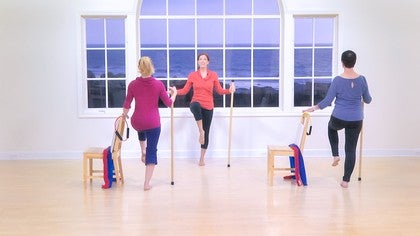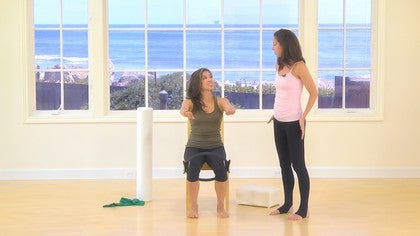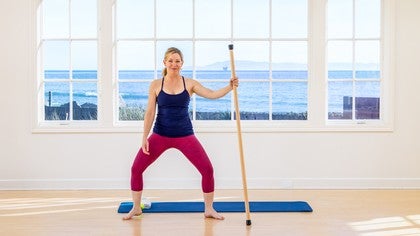Description
About This Video
Transcript
Read Full Transcript
Hi everyone. I'm here for Mat class today. Specifically geared toward older clients or older people, older students, teachers that might be watching. I've got tennis ball, a Gondola Pole, and a towel. You can also use a pillow for the head cushion if you're at home and watching this and you're not a teacher. If you have a small ball for a like a tennis ball, please get one of those little hand towel or a small cushion. You, if you don't have this type of pole, you can use a broomstick or the back of the chair or even the wall. Um, I have a soft spot for older clients.
Some of you might know that and it's, it's just a part of who I am. So I teach at my own studio. I teach lots of people in that demographic, and we have very strong women in my studio. They might be past 50 years old, but they certainly can work hard. So some of these exercises will do that. Some are a little more gentle, but I have a special client who's watching this right now, and this is hi, I'm saying hi to Meryl. Um, and she requested me to do a class for her. All right, so here you go Merrill. Everybody take your tennis ball, put it down in the ground and start rolling your foot over the, the ball. I don't really have a preference of how you do this. There are other classes that I give you that do have some breakdown.
I want you to just press lightly against the ball and try to not miss any spots. Okay? You can go to slow pace. You can go at a quicker pace. Um, something that I know about some older clientele is that the, the bottoms of your feet are more tender. You don't have as much of the fat pad in there and teachers that are watching, if you're not aware of that, it's true. They will tell you my feet kind of hurt, you know, doing certain things. So you have to start to learn how to strengthen the feet and beyond the feet, but be cautious and aware and sensible to what they can and can't do.
Why I'm doing this is to get some appropriate septic awakening, all the little tiny nerves and appropriate sectors at the bottom of our feet, like little antenna. I think of them as little antenna kind of tuning in. Okay. Really important when we are about at near the end when we do standing balance. So as you do that foot step down and so always wise to do a compare and contrast I think is really important. It gives you an opportunity to feel the difference between one side and the next. And so of course we'll do the second side. If you're doing this right now, when you're having difficulty with your balance, please use your pole. You can use your wall. Uh, you know, all that is good. So working with older clients or uh, older students is rewarding because you guys can do lots of things.
It's very empowering. We won't be rolling, we won't be doing a lot of flection in this class. Lots of balance and hip extension and axially longation through your spine. I'll talk about all that in just a minute. A little bit more of a breakdown. So just keep massage in the feed. About 10 more seconds or so on your second foot.
Okay. You can see that. I don't want you to think of your body as stiff and rigid like this, but more of just the direction of up. Okay, so axial being up, we can think of from the floor all the way up to your hips and then you might think of your mere hips growing taller through your sh, up to your shoulders, and then your neck up and out through the top of your head. All right, take that concept and raise your arms up. Now Merrill, be careful with your arm. Don't take it any higher than you know what to do. Okay? Same with anybody else out there. If you're having some shoulders stuff, if this might be your range, that's fine. If you're able to go further, that's fine too. What I want you to think mostly about is your spine anyway. So I might just show it like this. Okay.
Can you elevate and put more space between your pelvis and your last rib cage? Last rube on your rib cage. So even if your hands are here, I'm going to just use this one. Now this feels pretty good. I can create that sense of going more upward. The hands on my head, my skull reaching into my hand actually is made that sense more, um, pronounced in my back muscles. Okay, so this is some example of axial elongation up. Alright, now I'm moving on. I'm going to take my arms up and just start to reach one arm a little higher than the other. Just a little bit. Think of this as, uh, your ribs walking up your spine. Like, if your spine were a ladder and your ribs are walking up this ladder, why I want you to do this is to get some motion and mobility in this section of your back right in that mid back. Okay. And just to massage a little bit, move, can it get some mobility? Okay.
And then lower your arms. Now how are we going to get down to the floor? How are you going to get your student down to the floor if they have difficulty getting down there? So something that we work with a lot with, um, older clients is a hinge activity or hinge motion. So I'll place my feet fairly apart, something like that, and we'll bend my knees slightly forward, but goes back, think about your tailbone. Uh, like a bee Stinger. This is a cue I use all the time in my classes and it's fun that your s your beasting is going that way, okay? But there's another senior off the top of your head.
So you've got that axial elongation connected. Now here's an option. You could keep squatting down. Okay? You know the floors there. I'm going to start to put one hand down than the other if you need to, you can do this against the chair. Also. I'm lowering myself down on my knees. Now if you've done that or watching it and you're like, I can't do that, here we go. You can put one foot forward. So Merrill, this might be your choice. Step a foot forward. Now you've got two knees. You're bending both knees down, hands on the front thigh, B singer out.
Axial elongation. Hands need to get to the floor. So I want you to keep descending, keep descending, put your knee down, step back. Move that foot out of the way. Now church, turn toward me everybody and sit on your hip. Okay? This is a time for your, your head cushion wants you to put this right behind your head. Roll onto your back. Okay? Why? This is behind your head is for some support, but I also want you very lightly to think about your, your head making a little indentation in the pillow or your towel. Just a very slight little indentation, okay? Or like you're pulling your, your brain back, the back of your brain back. All right?
Some of these images work. Let's take a deep breath now. Exhale and bring one of your legs up to a tabletop position without disturbing that head cushion or your neck or your rib cage moving. Bring the other leg up. Okay. So I want us to begin moving the legs and just taking it easy. Little. Think of it as a walk. Breathing in and out.
Can you axially Elongate your spine? Here you can. There's energy going out the skull and down and out your tailbone. Change your feet. Two feet flex. I'm thinking heel on the mat. Not as specific on how many repetitions. Keep those legs moving when the working from your hip joints.
So for a lot of the our older clients, we need to keep those hips strong and mobile. Strong and mobile. Okay. Lower your feet. Step your feet apart. Want you to lean both of your knees to one direction. I'll choose to reach to you. Move your hands out of the way. So as you lean your knees over to one direction, you'll feel a wonderful stretch on this top side. Most likely, if you're able to take an arm into this exercise, it's the same arm as the leg that's on top.
So my right knee is the top leg here. I'm taking my right arm and reaching it to the wall that's behind me. You can wiggle your fingers, you'll feel a really nice stretch in the side of you. Think about axially long gating your spine axially, okay? And then size. Nothing too difficult, but feel should feel really good.
Okay, so we're trying to do anything we can to maintain height in our spine and no pressure or compression in our spine. Reach and breathe those tissues. Love that oxygen and that stretch. Okay. And then arm comes down, knees come to center. Okay, gals, let's bring her and people bring your legs right up to a tabletop position again and arms up. Now, palms facing each other, very controlled. I want you to bring both of your shoulder blades back onto the mat. Okay? Notice that you can bring your shoulder blades back without thrusting your rib cage. Now, do only what you can with your shoulders.
But I do want you to open your arms wide. This is very good for opening to some tight chest, tight shoulders and posture. Okay? And bring your arms up just three times. If you do this class a few times, you can add hand weights later if you want to. Okay. Only take your arms as where they can go. But put yourself in real life.
And as you stand up and as you talk to friends and you're at your parties, what do you want your posture to look like and feel like this is a really good place. Even just on the ground to thing. I'm open, I'm confident, I'm poised, my shoulders look good, my spine looks healthy. Okay? And then bring your arms up and lower one foot than the other and bring your hands down. Extend a leg so you a little windshield wiper type of movement with the other leg. So I'm taking my knee up first, extending the leg, slight external rotation with this leg. And before you move your thigh, feel that your pelvis is sinking into the mat. Okay? Your abdominals are helping hold that pelvis down.
All I want us to do is take the leg over the midline. Now if you have osteoporosis or I'm sorry, hip replacement, this is not indicated for you, okay? You would just take your leg here and you work on going the outside way. All right? That's the safest rule. If you're okay, I want you to cross that leg over and then away you can make it small. Kay, holding your hips on the mat nice and steady. So again, I talked about those hips. We need mobility and strength in there.
Now let's move into leg circles. Traditional Mat circles three times. Again, you can keep these small hip replacement. You just want to go straight down, out and around, thus reverse it. They don't have to be big
Anytime that talk about that, I would suggest you look at some of those, but also it's the you. We want the combination of these deep abdominal muscles inside your kind of lower abdomen and hip joint region. Think of all of that. Not even think. Activate those muscles in an upward direction inside your body. Okay, so take your second leg and even here before we do the second leg and circle and windshield wipe deep inside, you want to think up muscles up inside toward the top of your head. You'll feel that windshield wiper, your leg. You did about five.
Okay. How still can you keep most of your body? How stretched can you keep through the top of your head? If you're feeling that this is a little too difficult, you'd bend the other knee and put that foot flat, absolutely fine to do. I'll keep showing it this way.
Let's go for leg circles down a little out to the side and up.
Now put both of your knees in tabletop. Put your hands on your thighs or your knees and thighs and just hold a stable position and why don't you to let your lumbar spine get closer to the mat. You have to press from your stomach and your abdomen. Your shoulders are back. Okay? You're at a cocktail party, you're at a function and your shoulders look good. You've got good posture. We don't have that going on, okay?
Use Your Mat and press your shoulders back. You'll feel this. Just hold onto it. We're just doing an isometric,
I want you to focus on the strength of stability in your abdominals. In spine. You're axially, elongated. Your shoulders are in a good, healthy position. Okay, one more on the other side and now relax. Good to do that. Two hands on your knees. Stir your thighs a little bit. All right, so let's move onto sideline work.
I'll face you, okay? Now this is really where this head, this cushion comes in handy if you need it, you can roll it up a little bit more here. Stretch your arm out. If you're not able to do that from because of shoulder dysfunction or rotator cuff or frozen shoulder, you might do this, okay? And then your head will go on your cushion. In other words, make it comfortable. Teachers find a way to support your client so that they can do this, but you do want to get yourself as much on the side of your body as you can. All right, and let's begin with our legs stacked.
Okay? Why? I was fidgeting there for a moment. I don't. You can't see it the best from the angle that we're in right now. What is fine? I can talk about this. My head was forward of my shoulders, kind of comfortable, but if I took this posture and stood up, I would be letting gravity win and I'd be rounded in my shoulders. My chest would probably be kind of caved in and I certainly wouldn't be in my axial elongation connection. Okay, so I'm regrouping.
You'll see a big difference, I think. Oh boy. So I actually feel in getting into that position a, an openness across my chest here, my upper back engaged. That's a good thing right behind those shoulders. Okay. Bend your bottom knee. If you're challenged right now in your balance, that'll make it easier otherwise to come along. We're just doing easy up and down leg five times.
So side lying exercises are a lot about stability and our balance. Stay up there for five. Now I want you to take your leg and externally rotate it means turn it out and then turn it just back to parallel. You can think a kneecap toward the ceiling. Knee cap toward me or thigh bone rolls back.
Thigh bone rolls toward the camera toward me. Okay, two more. Okay. Now it's going to get a little more intense. Hold it rotated outward and make a little forward action lifted a little and then move it back. I'm going to bend my bottom. Me Focus on the leg movement back more than the forward. Okay. Little forward, but a lot to the back.
That's that hip extension range. We need to keep those hips healthy and you'll probably feel your buttock starting to contract here. Your glutes. Let's do four more. We can handle more than these or more. Okay, and four. And our last one, I want you to hold your leg behind. Take the top arm. I do this a lot. I did this in a reformer class just a little while ago.
I'm okay with letting you take your head down, your eyes looking down. You can still axial, elongate out the top of your head, but your, your gaze can be slightly down, but really everybody reach. It's OK if your shoulder blade comes up towards your head a little bit, that's okay. Reach a little more. It should feel really, really good to open yourself up like that and stretch. Okay. Now bring your arm down in your iin together. Still on our side.
We'll do just one series of, of an externally rotated motion for your hip. Move your, your thighs, not up, but a little bit more back. Okay? And and try to against a writeup on the side of your hip. Now Flex your ankles and begin to open your top thigh. You'll feel a fairly strong contraction right here in the back of your hip, I hoping. And then clothes, let's go. 10 of these.
We can handle quite a bit of repetition. So again, we're looking to strengthen the posterior aspect of our pelvis and our hip while we open and gain mobility in the joint. Okay, here we go. Open and put your hand on your thigh. Let's notice that extra little bit of resistance can really kind of zone in and make this effort stronger last time and hold. Now I want you to lift your thigh up. Notice that you can relax your foot. Your knee is higher than your foot. Just hold it. Okay.
Now the little circles, again, going back thigh back, you may have a different range of movement than you did with the straight leg, probably so five all the way to ten six, seven and eight and nine and 10. Okay, bring your leg down. Now I want you to Tuck your knees way up. Now remove your cushion and put your head just on your arm. Now hand on your shoulder, let your spine and your ribs rotate and look up toward the ceiling. If you're a person that can do this with both arms outstretched into a t, go ahead. It feels really nice for this video.
I'll just kind of keep my elbow down here. Now I do want you to roll back onto your side and face me. We'll do that two more times. Focus again on axial length there and now take that into a rotation. Okay, and face me in one more time.
Hopefully this is feeling good. Alright, let's just do those pieces on the other side. So pick up that cushion, come all the way up and just come down, up, down, up, down. Take yourself out. Now find that really nice long body. I'm just going to cushion my head here a little bit. Legs extended, axial, axially, elongate. Try It yourself. Legs up and down.
Focus on good posture. I say that to my students a lot. What would you like to look like when you're talking to your friends in public? No. Slouch. Tired. Shoulders right up and down. Open Up. Yeah. No. Take your leg and hold it up externally. Rotate and then take it back to parallel. This is hip joint, femur back, femur forward thigh bone rotates back thigh bone forward.
You can do a little bit of abdominals to spine here. Oh, help your Mallon's. Okay. Once again, hold it in. Turn out now bringing it very slightly forward. Ah, up and now behind. Use this hand for balance as well as bending your bottom knee. Here we go. Front, up and back. We did 10 of them.
Gradually they can get bigger. Increased range of movement. Always think of them the length in your body though, the lengthen your spine. If you're feeling that kind of tight compressive pin genus in your lower back, that'd be an opportunity to kind of regroup your abdominals and maybe elongate through the [inaudible] sign up in your head. Okay, last one, and rest. Bring your knees together and then take your thighs back just a little bit.
Let's go into that clam, so opening the thigh and close hand on your leg. Like I said, that extra little bit of resistance will make your muscles work more good. Balance on the side of position and four and five and six. We went to 10 here's seven, eight, nine. We want to keep those hips strong. Okay, we hold here, lift the thigh, relax your foot. We did some more circles back. They talk a lot about keeping strong hips. We need those when we come up into standing vertical in gravity.
Take your, we did a circle and take your leg behind you. It's completely fine. This happens to me in class all the time at my home studio. So take the leg back. We then took our arm in an opposite direction. You can let your gaze, your focus, look down, breathe and reach. Marilyn probably caught that.
She's probably wondering if I was going to and the reach and reach a little more. Okay and now bring it in. Now we're ready for the rotation cushion away. Come down and then take your, your hand behind your head. Fingertips to shoulder and here we went into a slight rotation. Knees were higher up. Should feel good. Okay. Now your might be wondering about osteoporosis and rotation.
He might've been wondering that a little while ago. It is okay to do gentle rotation as long as we have spoken of that length and we've decompressed enough to allow, this is very gentle. We're not loading. Okay, but you, you can't not twist in life. It's you know, unless you're, that's another long story. Unless you're injured, modify. But for healthy bodies, we need to keep those tissues mobile, right? We need to keep moving. Okay.
I could go down a long conversation. One more thing on the ground and then we have to come up and do some a standing balance work. So I want everyone to put their hands right by the side of your chest wall. Start with your forehead, hovered above the mat or take your cushion and lightly rest. Okay.
Close Your Eyes for me and I want you to really honest to be about what this is. Your posture. If you're standing in real life, talking to friends, you're at a party, a book club, et Cetera, no rounded shoulders, right? Don't let those shoulders round. So all I'm going to have us do is press them back. If you're wearing a beautiful necklace at those parties, show off that necklace in the front of your chest. Okay? Legs are slightly apart. Can you abdominal? Bring your abdominals up.
Now let's add to this. Feel that energy at the top of your head. If you like the beasting or image you can use that. I've lifted my head up off of the towel cushion. I'm not going very high. Focus on length. You should be feeling this right in the mid to upper back. Gently come down.
Okay. Move your hands back. Two more to go. What do you want? Your shoulders, your neck, your posture to look and feel like so these exercises should translate and integrate into our real life.
Okay. I'm asking those questions because they're real life moments. Sometimes you can't. You don't have the use of your arms to help you. If you have a shoulder injury, you'd have someone help you. You would do the best you can. All right, now we need to get up all the way, so I'm turning over onto my knees. Bring my body up, right. I'm stepping one foot forward. Now hands on that front side.
Before you rush through this, bend those toes down and push yourself up. Okay? It may seem simple and sounds silly, but those are challenging things. Okay? Time for the pole or your stick or your broomstick and put it right in one hand. Stand up with your feet slightly apart and I want it to just easily rise up to the tippy toes. Now, these are not high lifts. These are balanced lifts.
Okay, so I'm thinking maybe my heel comes. Heels come up about an inch or two. You've heard me talk about this before. What we don't want is the ankles to roll, so you're really working on keeping even weight. First, second, third, fourth, fifth toes. They all matter one or two more and then stay up on this next one. If you don't need that stick, you can certainly put it away or at least lighten your hand. Hold on it. Okay, stay with me. I'm going to put this hand over here just for placement and then I want you to turn your eyes and look somewhere else in the room.
It doesn't have to be a big movement, but just focus on something else. Change it. Look somewhere else. Change. Look all the way around the other side. Now this is too challenging. You need to lower your heels to the floor. Look, again, maybe two or three more gays is somewhere else. So by changing our visual location, what we're looking at, we're tapping into a wonderful system of balance in our body, our visual system, and look straight ahead. Okay, time to lower those heels and change hands. So we're going to go over here.
Now let's keep it simple. Hand over on the shoulder. Rise up again, a small lift and we're taking up an alternating heel pattern. We're on the reformer. We call them the walk in place. Notice the knee is pointing straight ahead. You don't want the knee to fall in this way. You don't want the knees to fall open.
See if you can attract them straight ahead. Okay? If you're healthy with your feet and ankles, feel free to rise higher in between lighter use of the pole. Good. Let's just count four, three, and two and one. Now lower the heel, lower this arm, and I want you to bend your knees and just tap your heels on the floor. It's a little bit of a bone stimulation on the ground. Okay?
Pause. Turn your feet outward just a little bit. Do the same thing, not really counting change hands. I know it looks a little funny and then come here. Do the same thing with your feet apart. Okay? Not a real big dancer turnout, but certainly a wider step here and bend those knees. Pelvis pretty low. And then same thing with your heels. So it's some coordination.
It's an impact which is healthy for our bones. Go a little faster. My face is shaking and then stop and then bring your leg and just feel what you feel. Notice what you feel. There's usually a little bit of vibration in the legs. Step together. Now, one more standing balance. I want you to take that, that axial elongation, that upped, you know, I'll give you this reference here. If that was through us, that whole sense of length and hinge at your hips. Your knees will bend, you hinge at your hips. I'm reaching this pull out.
I'm going to take the opposite foot out and lean down a little bit further, so I'm trying to flex or crease fold in my hip joint. Take this other arm out and lower and lift the arm. You'll notice the muscles in your back working. Okay? If you don't need that stick, you can put it down or wait into the other side or put it away. Okay. Focus something on the floor.
Look out and stare at something that helps your balance. You're going to need a hold there. Hold, hold, hold that. Can you lift that foot off the floor? I'm going to take it up off the floor and take it behind me and just hold it there. Okay. Changing places. I'm on the count of three, straightening the standing knee, bringing the back foot toe to the knee, one, two, three, and lift. So let's repeat that five more times.
Bend your knee, send your standing leg back and then come back up to standing. Okay? If this is too much for your standing balance, build up to it. I would understand that this is not easy. You could always just put your foot on the floor and then bring it in here and bring it to the floor. Then bring it in one more. Someday you'll just be doing this and you'll be surprised.
You'll be very surprised where that string came from. Okay. Changing sides, everybody. We're almost done and want you to bend your knees again. You've got your bee pointing in their directions. You take that outside leg out to the side for a moment. Just hold that stick here, our amount, and we just lowered and lifted the arm just down and up. If you need or want more challenge, you hinge at your hip and you lower yourself lower to the floor.
Be Mindful that you don't stick your hip out to the side. One more time. Hold your arm out. Okay. Now the bigger movement. Lift the foot off the floor and take a behind you ready and go take it behind. Hold. Okay. On the count of three, we're coming upright. Axially, elongated. One, two, three, tall and back again. Let's inhale back. Exhale up. Inhale back.
Exhale up
I'm going to hinge at my hips to lower it to the ground. Bring yourself all the way up, right. Take your arms again if you can, just like I said at the beginning of class, take them all the way up. I like to, um, seal my fingertips together. I've even talked about this in class before that I think about holding something very important in my hands and holding it high above me, high above me. Reach that important, whatever it is. Way Up now when you turn and look your eyes toward me, keep those arms up. If you can.
Your last axial elongated moment for the day in this class. So our goal, keep that sense. Lower your arms, lower your arms, and just feel hopefully your field tall. You feel like you've gotten some work in your hips, your upper back muscles, your balance. That was my goal for the class. So keep coming back to it. Let me know how you do Merrill. I hope you had fun with that one is a little longer than I thought, but I hope you practice. Okay. I'll see you very soon, everybody. Bye. Bye.
The Teacher's Corner: Improving Balance
Comments
spots that need to be respected before they can get stronger.) For me, the class is challenging in many places but not at all discouraging and I feel energized at the end. What could be better?! Thanks so much for this blessing, Amy!
You need to be a subscriber to post a comment.
Please Log In or Create an Account to start your free trial.


























